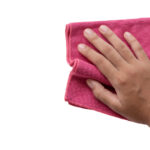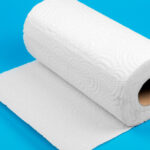Kitchen towels come in many varieties and go by different names like cup towels, dish towels, tea towels, and more.

But what exactly are the differences between these types of towels?
What is a Kitchen Towel?
A kitchen towel is a broad term that refers to any kind of towel that is primarily used for kitchen tasks like drying dishes, hands, and wiping counters.
Kitchen towels are designed to be more durable and absorbent than regular towels. They typically have a thicker weave and are hemmed with reinforced stitching so they can withstand frequent use and machine washing.
There are many different types of kitchen towels that all serve various purposes in the kitchen:
Having an assortment of kitchen towels on hand helps keep your kitchen clean and organized. It’s recommended to have multiple towels readily available so you always have a fresh one when needed.
Common Kitchen Towel Materials
Kitchen towels can be constructed from a variety of materials:
Linen
Linen is a traditional fiber used to make tea towels and other delicate kitchen textiles. It comes from the flax plant and is valued for its lightweight, lint-free, and quick-drying properties.
Linen has a smooth surface that won’t scratch fine china or glassware. It makes great tea towels, napkins, table runners, and appliance covers.
Cotton
Cotton is the most popular material for modern kitchen towels. It is soft yet durable, and the dense weave makes cotton towels very absorbent.
Cotton towels can withstand frequent machine washing without losing their shape or becoming scratchy. They are gentle enough for hand drying and cleaning dishes.
Organic cotton kitchen towels are a great eco-friendly option.
Terry Cloth
Terry cloth has looped piles that create air pockets, making this fabric ultra-absorbent. It quickly soaks up large amounts of water.
The fluffy texture gives terry cloth towels a scrubbing effect for cleaning. But the lint can transfer to surfaces, so terry cloth is better suited for hand towels than for drying dishware.
Most Absorbent Kitchen Towel Material
The most absorbent kitchen towels are made from terry cloth. The looped fabric construction traps moisture effectively. A high cotton content will also maximize absorbency.
Flour sack towels and huck towels made from densely woven cotton are also very absorbent options. They don’t have the scrubbing texture but won’t leave lint behind.
Linen absorbs quickly but doesn’t hold as much liquid overall compared to terry and cotton towels.
Key Takeaway: Terry cloth is the most absorbent but cotton is best for lint-free drying.
Tea Towels vs. Dish Towels
Tea towels and dish towels are two common types of multipurpose kitchen towels that are frequently mixed up. But there are some notable differences between them:
Origins
Materials
Texture
Intended Uses
While tea towels and dish towels have some crossover in utility, their origins and materials make them better suited for different kitchen jobs.
Tea Towels vs. Flour Sack Towels
Flour sack towels share a lot of similarities with tea towels:
The main differences come down to origins and thickness:
Either works well, so the choice comes down to personal preference on thickness and patterns. Vintage style flour sack towels evoke nostalgic farmhouse appeal.
Brief History of Kitchen Towels
To understand the origins of different kitchen towels, let’s look at a quick historical overview:
How To Use Tea Towels
Keep these tips in mind to make the most of decorative tea towels:
How To Use Dish Towels
Dish towels have some crossover uses with tea towels but here are their strength areas:
Rotate dish towels frequently and wash after each use to prevent bacteria build up. Have multiple dish towels on hand so a spare is always ready when the current one gets wet.
How To Use Flour Sack Towels
Some clever ways to use flour sack towels to their full potential:
The tighter weave makes flour sack towels more versatile than terry cloth dish towels for crafting and household uses.
FAQs
Are tea towels and dish towels the same thing?
While sometimes used interchangeably, tea towels and dish towels originated differently and work best for different kitchen tasks based on their materials. Tea towels are meant more for drying and polishing while dish towels are better for hand drying and surface cleaning.
What’s the best material for kitchen towels?
For versatility and performance, cotton is generally the best kitchen towel material. It’s soft yet durable, absorbent, and affordable. Choose organic cotton or linen for a lint-free towel that won’t scratch dishes.
How often should you wash kitchen towels?
It’s best to wash kitchen towels after each use to prevent bacteria growth. Have multiple towels on hand so you always have a clean spare ready. Wash dish towels separately from general laundry using hot water and bleach.
What can you make from vintage flour sack towels?
The tightly woven and durable cotton construction makes vintage flour sack towels great for crafting projects like quilts, doll clothes, tote bags, aprons, and more. They can also be upcycled into rag rugs, produce bags, and other household items.
Are flour sack towels good for dishes?
Yes, the flat weave cotton is gentle enough for hand drying glassware and dishes without leaving lint behind. Flour sack towels are absorbent and multipurpose for drying, straining, wrapping, and cleaning kitchen items.
Conclusion
Kitchen towels are available in a wide range of fabrics, weaves, and sizes to suit an array of functions. Different types like tea towels, flour sack towels, and dish towels all have their own origins and ideal uses.
Focus on softer, lint-free cotton and linen towels for direct dish and glassware drying to prevent scratches. Terry cloth works well for hand drying and scrubbing due to its ultra-absorbent piled construction.
Evaluate your needs and kitchen tasks, then stock up on a variety of towel types and designs to keep your kitchen clean and stylish. Rotate towels frequently and launder after each use to maximize freshness and prevent bacteria. With the right assortment of quality kitchen towels, you’ll be ready to tidy up any cooking or baking mess!








